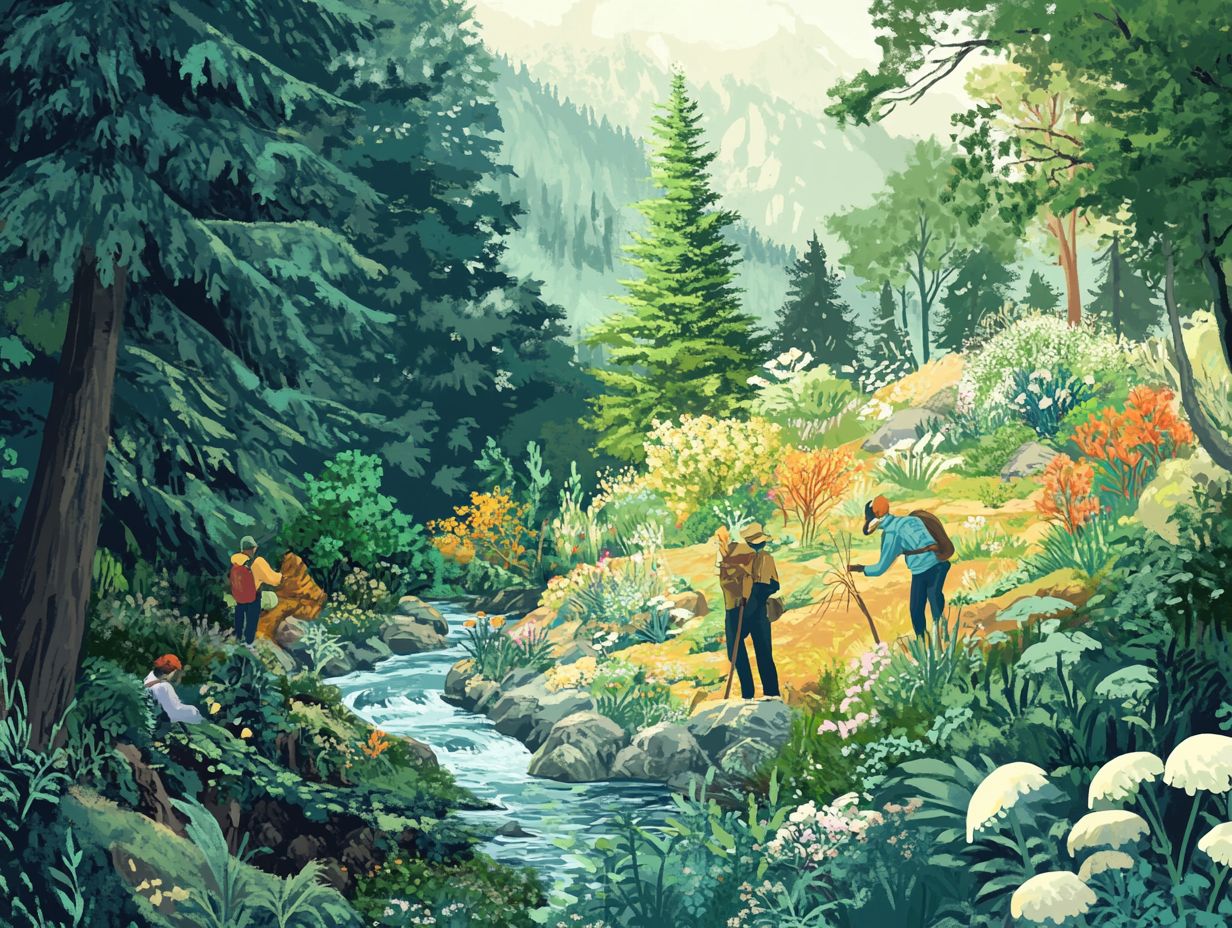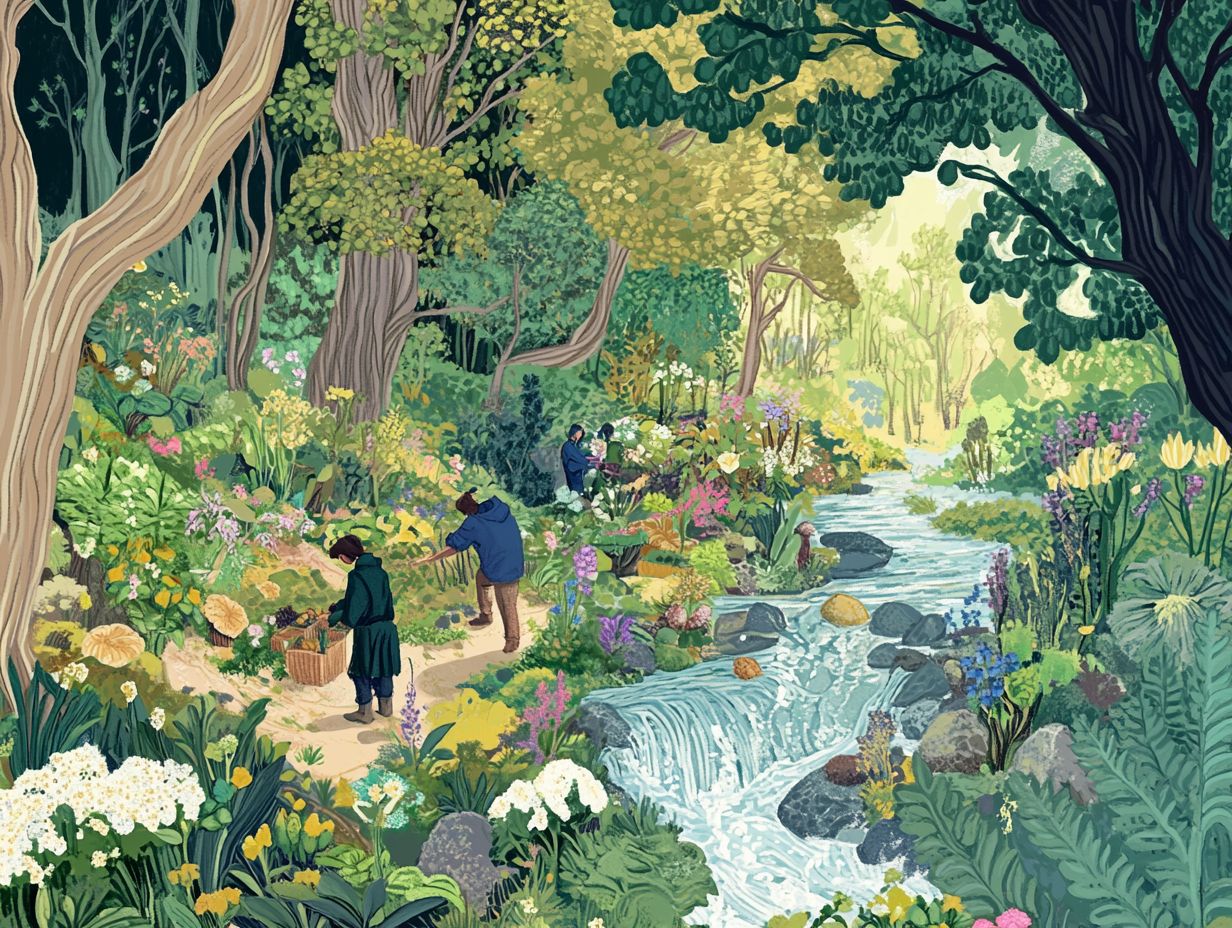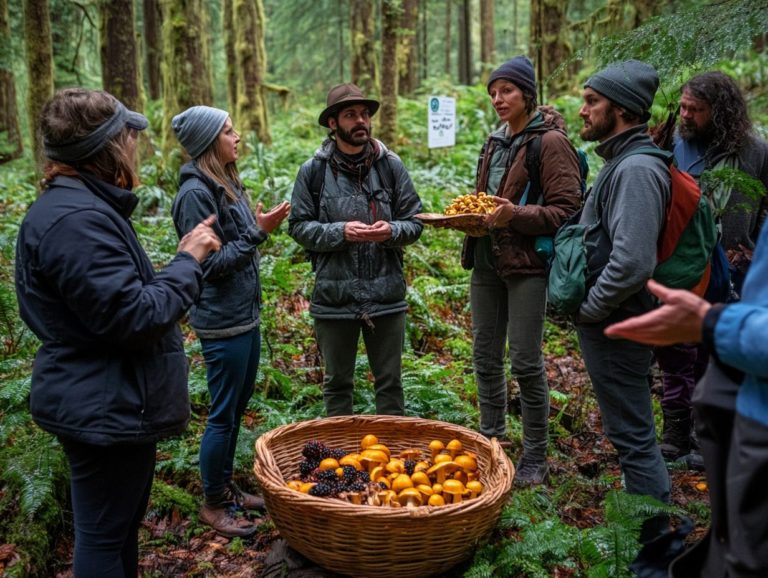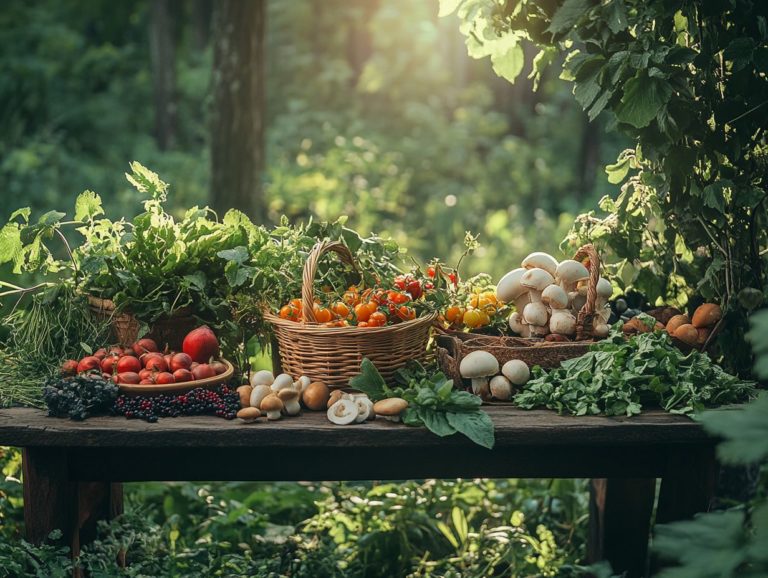Balancing Foraging and Ecosystem Health
Foraging is vital to keeping our ecosystems healthy and thriving! It maintains the delicate balance of ecosystems, impacting everything from wildlife health to environmental stability.
This exploration delves into how foraging supports ecosystem equilibrium, highlighting its benefits for wildlife and the environment. It also addresses the challenges introduced by human activity.
You’ll discover sustainable foraging practices and collaborative conservation efforts that are essential for preserving these vital processes for future generations.
Uncover the intricate relationship between foraging and ecosystem health, and find out how your understanding can contribute to a more sustainable future.
Contents
- Key Takeaways:
- The Importance of Foraging in Ecosystems
- Challenges in Balancing Foraging and Ecosystem Health
- Strategies for Sustainable Foraging
- Future of Foraging and Ecosystem Health
- Frequently Asked Questions: Embracing Urban Foraging
- 1. How does foraging impact ecosystem health, particularly in urban areas?
- 2. What factors should be considered when balancing foraging and ecosystem health?
- 3. Can urban foraging be sustainable for both humans and the environment?
- 4. How can we promote a balance between foraging and ecosystem health?
- 5. What are some examples of foraging practices that can harm ecosystem health?
- 6. How can we ensure the long-term sustainability of foraging and ecosystem health?
Key Takeaways:

- Foraging plays a crucial role in maintaining balance and promoting the health of ecosystems.
- Human activities and disruptions pose threats to foraging and ecosystem health, highlighting the need for sustainable practices.
- Collaboration and conservation efforts are key to ensuring the future of foraging and preserving the health of ecosystems for generations to come.
The Importance of Foraging in Ecosystems
Foraging holds a crucial place in ecosystem health, significantly influencing biodiversity and sustainable food systems. It forges a deep connection between humans and nature, honoring traditional practices.
When you gather edible plants like black walnuts, you re not just filling your basket; you re actively promoting ecological balance and fostering a sustainable food landscape. This practice is vital in addressing critical challenges such as species extinction and climate change.
Role of Foraging in Maintaining Balance
Foraging is essential for maintaining the natural order that helps plants and animals thrive. It promotes a rich variety of plant species in the environment, supporting food forests and enhancing ecosystem health.
When you engage in foraging, you re not just collecting edible plants; you re gaining a better understanding of the intricate connections among various species around you. This practice aids in the natural dispersal of seeds, fostering plant reproduction and ensuring thriving ecosystems.
By utilizing native flora, foraging fosters a harmonious relationship with the environment, ultimately increasing populations of beneficial insects and wildlife. This sustainable approach to sourcing food enriches biodiversity and fortifies the ecological framework, which is essential for the well-being of both the planet and its inhabitants.
Benefits for Wildlife and Environment
The benefits of foraging extend beyond satisfying your appetite; they offer remarkable advantages for wildlife and the environment, enhancing biodiversity and promoting sustainable food practices.
Engaging in foraging plays a vital role in maintaining the delicate balance of local ecosystems. By collecting various plant species, you support native wildlife that depends on these resources for survival and facilitate the growth of new plants through seed dispersal.
This practice helps maintain soil health and structure while fostering a rich variety of flora that serves as habitat for countless creatures. Embracing foraging principles deepens your understanding of local ecosystems, highlighting the interconnectedness of species and underscoring the importance of preserving natural habitats for future generations.
Challenges in Balancing Foraging and Ecosystem Health

Foraging offers significant benefits to ecosystems, yet it faces a range of challenges from human activities and invasive species that disrupt the delicate balance essential for maintaining ecosystem health. To learn more about this important topic, check out seasonal foraging: protecting edibles and ecosystems in the face of climate change.
These practices are not just important; they are essential for our planet’s future! We encourage you to engage in foraging while respecting nature.
Human Impact and Disruptions
Your impact on ecosystems, especially in urban settings, creates significant disruptions to foraging practices. This is often driven by capitalism and raises serious environmental health concerns.
These disruptions take many forms, including habitat destruction and heightened pollution. They directly affect food availability for local wildlife. Urban development frequently encroaches on natural habitats, making it increasingly challenging for species to access the resources they depend on.
The constant presence of artificial lighting and noise pollution can disorient foraging animals, complicating their survival strategies. This scenario sets off a ripple effect that endangers not only local fauna but also the broader ecosystem.
We must act now to adopt sustainable practices! These practices can mitigate adverse impacts and promote a healthier environment for both wildlife and human communities, fostering collaboration among foragers and indigenous communities.
Threats to Foraging and Ecosystems
Foraging faces many threats, including species extinction and the unsettling rise of invasive species. These significantly contribute to biodiversity loss and challenge the sustainability of ecosystems.
These threats are amplified by climate change and habitat destruction. They further undermine the delicate balance of natural habitats.
Invasive species often outcompete native flora and fauna for essential resources. This leads to the decline or even extinction of indigenous species vital to their ecosystems.
The loss of these key players disrupts food webs, which are the complex relationships between plants and animals that show who eats whom. It impairs nutrient cycles and ultimately degrades the overall health of the environment.
This cascading effect jeopardizes the rich tapestry of life within these ecosystems. It also threatens the foraging practices that rely on them, creating a cycle that can be exceptionally challenging to reverse.
Strategies for Sustainable Foraging
Implementing strategies for sustainable foraging is essential for ensuring ecosystem health. It involves a thoughtful blend of practices, collaboration, and conservation efforts that honor the delicate balances of nature.
By embracing these strategies, you play a crucial role in fostering a harmonious relationship with the environment. This promotes both biodiversity and responsible resource management.
Practices for Maintaining Ecosystem Health

Practices for sustainable foraging go beyond mere harvesting techniques. They seamlessly integrate traditional knowledge that plays a vital role in maintaining biodiversity and ecosystem health.
Understanding seasonal cycles and recognizing which plants or fungi are abundant at specific times of the year allows for a balanced approach to gathering resources. This wisdom, often passed down through generations, encourages you to respect the natural rhythms of the environment.
By employing these time-honored techniques, you ll likely select only mature specimens. This ensures that younger plants can thrive, continuing to contribute to the ecosystem’s resilience and diversity.
Embracing these holistic approaches means actively supporting the intricate web of life around you.
Collaboration and Conservation Efforts
Collaboration and conservation efforts among foragers and indigenous communities pave the way for enhancing sustainable food systems. They nurture healthy ecosystems through the exchange of knowledge and practices, including innovative solutions.
By joining forces, you can tap into a wealth of traditional wisdom while incorporating modern techniques. This ensures that your foraging efforts not only honor the land but also enrich local biodiversity.
Indigenous communities play a vital role in this dynamic. They often act as guardians of their natural environments, benefiting both wildlife habitats and the availability of native foods.
Their expertise can guide you in adopting sustainable practices that safeguard resources for future generations. Through mutual support and respect, these collaborative initiatives significantly strengthen community resilience.
They improve the nutritional quality of available food and foster a deeper connection to the environment. Join your local community efforts to protect our ecosystems!
Future of Foraging and Ecosystem Health
The future of foraging is set to embrace innovative solutions tailored to tackle ecosystem health challenges. By doing so, you can actively combat climate change while promoting biodiversity.
This harmonious approach will enhance your foraging experience and contribute positively to the environment.
Potential Solutions and Progress
Potential solutions for enhancing sustainable foraging and ecosystem health lie in innovative practices. These practices harmonize with food systems and prioritize environmental sustainability, benefiting the Global South.
Integrating community-focused methods empowers local foragers while promoting biodiversity through the thoughtful management of wild resources. Techniques such as educational workshops and shared meal events nurture a deep appreciation for native edible plants.
Digital platforms connect foragers with chefs, fostering a sustainable supply chain. These collaborations can elevate the quality of local diets and create economic opportunities, all while ensuring that ecosystems flourish.
As you embrace these innovative strategies, you pave the way for healthier environments and resilient, sustainable food systems.
Frequently Asked Questions: Embracing Urban Foraging

1. How does foraging impact ecosystem health, particularly in urban areas?
Foraging can have both positive and negative impacts on ecosystem health. It can help maintain balance by controlling certain populations and promoting biodiversity, highlighting the connection between foraging and local ecosystems.
However, overexploitation of certain species or habitats can lead to negative effects, such as resource depletion and disruption of food chains.
2. What factors should be considered when balancing foraging and ecosystem health?
Balancing foraging and ecosystem health requires consideration of various factors, including the specific ecosystem, the species being foraged, and the methods and intensity of foraging. To learn more about this, check out how to balance foraging with conservation.
It is also important to consider the social and economic impacts of foraging on local communities and their dependence on natural resources.
3. Can urban foraging be sustainable for both humans and the environment?
Yes, foraging can be sustainable as long as it is done responsibly and in a regulated manner. This involves monitoring and managing foraging practices to ensure they do not deplete resources or harm the ecosystem.
Sustainable foraging can also provide economic benefits to local communities while preserving the environment.
4. How can we promote a balance between foraging and ecosystem health?
One way to promote balance is through sustainable management practices, such as setting harvest limits and protecting sensitive habitats.
Education and awareness about the importance of maintaining a healthy ecosystem can encourage responsible foraging practices. Collaboration between stakeholders, including foragers, scientists, and policymakers, is essential for finding effective solutions.
5. What are some examples of foraging practices that can harm ecosystem health?
Examples of harmful foraging practices include over-harvesting of certain species and foraging in protected or sensitive areas.
These practices can lead to population declines, habitat destruction, and disruption of the natural balance in the ecosystem.
6. How can we ensure the long-term sustainability of foraging and ecosystem health?
Regular assessments are vital to keeping our ecosystems thriving. They help identify potential issues and inform management strategies that adapt over time.
It is crucial to involve local communities and incorporate traditional knowledge and practices into management plans to maintain a healthy balance between foraging and ecosystem health.
Join us in embracing sustainable foraging practices that benefit both people and the planet!






